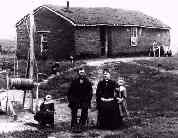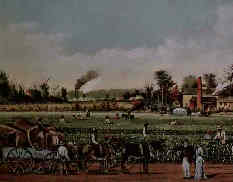

 Tomatoes were cultivated by the
Incas, thus making tomatoes an authentic American native crop.
Tomatoes were cultivated by the
Incas, thus making tomatoes an authentic American native crop.
Centuries later, tomatoes traveled from Peru where they grew wild in the Andes mountains, eventually migrating into Mexico, where they were known as "tomatis".
 Conquistadors carried tomato
seeds from the Americas to Spain and Portugal. Most of these
early fruits were yellow-skinned, and picked up such names as
"manzanas" (apples) and "pomi d'oro" (apple
of gold). They were considered poisonous but appreciated for
their beauty. Some considered the fruit a potent aphrodisiac.
Eventually the Spanish, Portuguese and Italians experimented with
tomatoes in recipes.
Conquistadors carried tomato
seeds from the Americas to Spain and Portugal. Most of these
early fruits were yellow-skinned, and picked up such names as
"manzanas" (apples) and "pomi d'oro" (apple
of gold). They were considered poisonous but appreciated for
their beauty. Some considered the fruit a potent aphrodisiac.
Eventually the Spanish, Portuguese and Italians experimented with
tomatoes in recipes.
After the French Alliance, Colonial Americans adopted tomatoes into their pantries, although seed catalogs still listed tomatoes under "annual and ornamental flowers".
 Tomatoes were first quoted on the
stock market around 1812. Breeding work was begun to develop
improved varieties. Two gentlemen advocates ate tomatoes publicly
to dispel the fear of toxicity. In 1818, an edition of American
Gardener lists the earliest known recipe for tomato ketchup
(credit is given to Maine housewives as originators of the first
ketchup).
Tomatoes were first quoted on the
stock market around 1812. Breeding work was begun to develop
improved varieties. Two gentlemen advocates ate tomatoes publicly
to dispel the fear of toxicity. In 1818, an edition of American
Gardener lists the earliest known recipe for tomato ketchup
(credit is given to Maine housewives as originators of the first
ketchup).
 The first greenhouse tomatoes
were produced for the market by farmers in Cleveland, Ohio.
Although botanically a fruit, the U.S. Supreme Court decided that
the tomato would legally be considered a vegetable because it is
usually served with the main part of the meal (an import duty
case was involved).
The first greenhouse tomatoes
were produced for the market by farmers in Cleveland, Ohio.
Although botanically a fruit, the U.S. Supreme Court decided that
the tomato would legally be considered a vegetable because it is
usually served with the main part of the meal (an import duty
case was involved).
 A glut of tomatoes, plus a
boycott by independent brokers and other users broke up a
potential "tomato trust" when there was an attempt to
corner the canned market. "Tomato clubs" were formed by
young farm girls who cultivated and canned tomatoes on their own.
A glut of tomatoes, plus a
boycott by independent brokers and other users broke up a
potential "tomato trust" when there was an attempt to
corner the canned market. "Tomato clubs" were formed by
young farm girls who cultivated and canned tomatoes on their own.
The nutritive properties of tomatoes, along with fruits and greens were recognized and publicized. The tomato is considered a valuable source of Vitamins A and C, retaining C even through cooking and aeration. They offer minerals as well, and are low in sodium.
 The tomato is now a food of
worldwide importance. The hydroponic tomato research and
development programs at the University of Arizona, starting in
the mid 1960's, have led the way to the development of the most
modern hydroponic systems in the United States. Early in these
programs, it was learned that light is the most important factor
in locating the best site for hydroponic tomato production. The
highest winter light conditions in the world are in the
southwestern desert region of the United States. This is when the
tomato prices are at their highest. Today, Arizona is center to
the most rapid growth of hydroponics in the United States. The
future for hydroponics has never appeared more positive.
The tomato is now a food of
worldwide importance. The hydroponic tomato research and
development programs at the University of Arizona, starting in
the mid 1960's, have led the way to the development of the most
modern hydroponic systems in the United States. Early in these
programs, it was learned that light is the most important factor
in locating the best site for hydroponic tomato production. The
highest winter light conditions in the world are in the
southwestern desert region of the United States. This is when the
tomato prices are at their highest. Today, Arizona is center to
the most rapid growth of hydroponics in the United States. The
future for hydroponics has never appeared more positive.